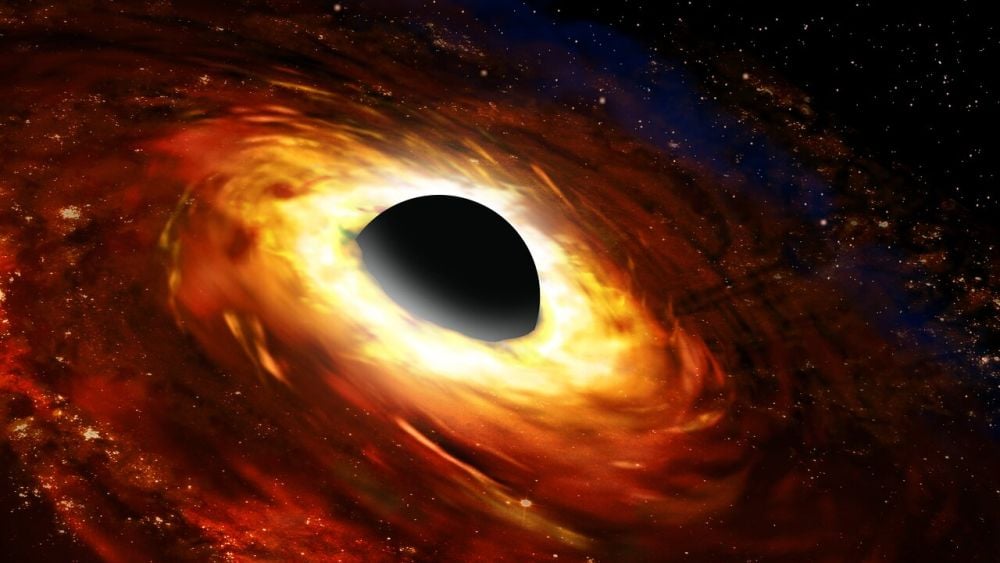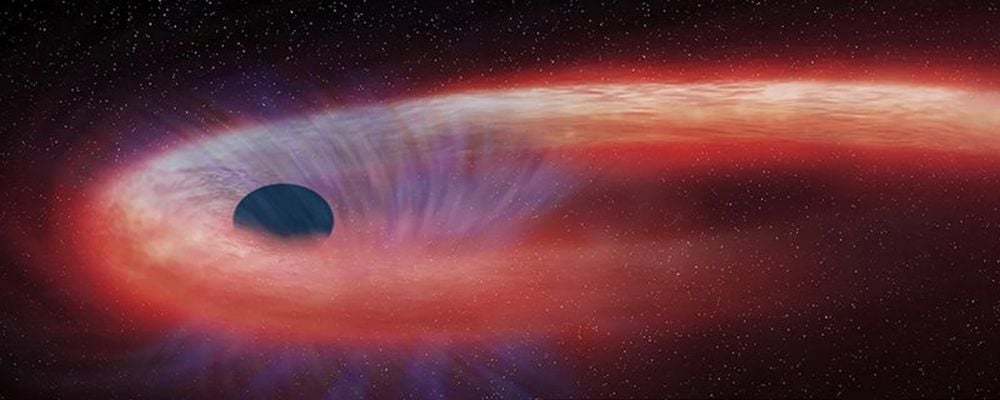Are astronomers on the precipice of discovering the first, elusive, intermediate mass black hole (IMBH)? That’s been the case for a while, as different researchers present evidence of them. There’s a candidate IMBH in the globular cluster Omega Centauri, and there’s evidence that they’re near supermassive black holes in galactic centers. Now researchers have found evidence of an IMBH devouring a star.
X-ray emissions are one of the primary ways that astronomers detect black holes. When material from a companion star gets drawn toward a stellar-mass black hole, the material is superheated in an accretion disk and emits x-rays. The same is true for supermassive black holes (SMBH) during tidal disruption events. The same is true for the hypothesized IMBHs and the new candidate.
The Hubble Space Telescope and the Chandra X-ray Observatory worked together to sense bright x-ray emissions from what appears to be an IMBH in a distant elliptical galaxy 450 million light-years away. The discovery is presented in new research titled “Multiwavelength Study of a Hyperluminous X-Ray Source near NGC 6099: A Strong IMBH Candidate,” published in The Astrophysical Journal. The lead author is Yi-Chi Chang from the Institute of Astronomy at the National Tsing Hua University in Taiwan.
“We report on the intriguing properties of a variable X-ray source projected at the outskirts of the elliptical galaxy NGC 6099,” the authors write. “The optical continuum can be modeled as stellar emission from a compact star cluster or an X-ray-irradiated accretion disk, consistent with the IMBH scenario.”
The source is called NGC 6099 HLX-1, and Chandra first detected it in 2009 when it flared brightly in x-rays. Astronomers have been monitoring it with the ESA’s XMM-Newton since then and watched as its x-ray emission varied over time. Observations from multiple other telescopes round out the evidence.
Researchers want to find an IMBH because they could be the missing link in the black hole hierarchy.
“X-ray sources with such extreme luminosity are rare outside galaxy nuclei and can serve as a key probe for identifying elusive IMBHs,” said lead author Yi-Chi Chang of the National Tsing Hua University, Hsinchu, Taiwan. “They represent a crucial missing link in black hole evolution between stellar mass and supermassive black holes.”
This panel shows four different images of NGC 6099 HLX-1 from different observatories at different times. HLX-1 is on the outskirts of the elliptical galaxy NGC 6099, about 40,000 light-years from the galaxy’s center. The bottom left image is from Chandra and the bottom right image is from the Canada-France Hawaii Telescope. Image Credit: Yi-Chi Chang et al 2025 ApJ 983 109
Astronomers know what tidal disruption event (TDE) emissions look like, and the Chandra found the same traits in the x-rays coming from NGC 6099 HLX-1. The Hubble also found evidence of a small cluster of stars near the candidate IMBH. That’s compelling evidence, since unusual clusters of stars with unusual motions is one way scientists confirmed the presence of the SMBH in the Milky Way’s galactic center. The stars near NGC 6099 HLX-1 are tightly clustered, meaning there’s ample material for the IMBH to feast on.
When a black hole feeds on a star or other matter, only some of the matter is pulled across the event horizon. The rest gathers in a swirling accretion disk where it’s heated up. The material in the accretion disk reached 3 million degrees F., which the researchers say is consistent with a TDE. That’s hot enough to emit x-rays, and those emissions reached peak brightness in 2012, three years after the IMBH was first detected, when they were 50 to 100 times brighter. Since then, it declined. This hyperluminous x-ray output is too bright for a stellar-mass black hole, but does fit the theorized range for an IMBH.
 An artist’s image of a black hole with an accretion disk. As a black hole draws material from a star, some of it gathers in a superheated accretion disk that emits x-rays. Image Credit: NOIRLab/AURA/NSF/P. Marenfeld
An artist’s image of a black hole with an accretion disk. As a black hole draws material from a star, some of it gathers in a superheated accretion disk that emits x-rays. Image Credit: NOIRLab/AURA/NSF/P. Marenfeld
“The observed properties of HLX-1 make it an unusual and intriguing source, difficult to categorize into ordinary classes of accreting compact objects,” the authors explain in their paper. What they’re observing could also be a background AGN, due to the nature of the x-rays they’re detecting, and the authors say it’s a distinct possibility. “We cannot completely rule out a distant background AGN or quasar,” they write, while also explaining that the AGN explanation is a bit of a reach.
One puzzling thing about NGC 6099 HLX-1 is that the x-ray emissions have an optical counterpart. This blue, point-like optical source could be from a star cluster that hosts the IMBH. This agrees with theory showing that IMBHs form in clusters. Or it could be coming from x-rays that strike an accretion disk and are then re-emitted as optical light. This interpretation also agrees with IMBH scenarios. “The morphology and brightness of the optical counterpart are consistent with a source at the outskirts of NGC 6099, such as a massive star cluster or UCD (ultra-compact dwarf),” the authors write in their paper.
How the emissions change over the next few years could explain exactly what’s happening with HLX-1.
“If the IMBH is eating a star, how long does it take to swallow its gas? In 2009, HLX-1 was fairly bright. Then in 2012, it was about 100 times brighter. And then it went down again,” said study co-author Roberto Soria of the Italian National Institute of Astrophysics. “So now we need to wait and see if it’s flaring multiple times, or there was a beginning, there was peak, and now it’s just going to go down all the way until it disappears.”
 This illustration shows a star being spaghettified by a black hole during a tidal disruption event. Image Credit: NASA / CXC / M. Weiss.
This illustration shows a star being spaghettified by a black hole during a tidal disruption event. Image Credit: NASA / CXC / M. Weiss.
In their study’s conclusion, the researchers emphasize that, “The source satisfies the main selection criteria for an IMBH.” It’s the simplest explanation for the observations.
“We discussed alternative interpretations and argued that an IMBH in a compact star cluster, fed by tidal stripping or tidal disruption of a low-mass star, is the simplest explanation consistent with the data at hand,” they write in their conclusion.
At first glance, that doesn’t explain why NGC 6099 HLX-1 started out dimmer in 2009 and then brightened by 50 to 100 times in 2012. “At first sight, the 2009 detection seems to rule out a single TDE,” the authors write.
The best explanation is a star on an elliptical orbit being periodically stripped of matter during close approaches to the IMBH, something observed in TDEs around SMBH. This explanation also explains the variable x-rays from other candidate IMBH.
“One possible answer is that HLX-1 is fed by tidal stripping of a companion star on an eccentric orbit (partial tidal disruption). This is a model that has been suggested, for example, to explain the repeated X-ray outbursts in the best-known IMBH candidate ESO 243-49 HLX-1,” the authors explain in their conclusion.
There’s another scenario that can explain NGC 6099 HLX-1 and its dim-bright-dim luminosity pattern. The initial rise in luminosity in 2009 could be from shocked gas in an accretion stream that intersects itself. Then the peak in 2012 could be from the disk accretion phase. More observations will help astronomers figure it out.
“Follow-up X-ray observations will be needed to determine whether the X-ray source is now steadily declining along the expected TDE track, whether and at what luminosity threshold it will switch to the low/hard state (which will constrain the BH mass), or, conversely, whether it will rise again in the future, if the feeding source has not been completely disrupted,” the researchers write.
Real answers for NGC 6099 HLX-1, and for the question of IMBH existence, rely on more observations. If IMBHs are an intermediate stage between stellar mass black holes and SMBH, then finding them as they grow through accretion is critical. There’s a proportional relationship between black hole mass and the mass of the hosting galaxy, and finding more IMBH would help strengthen that association, too. If astronomers can find more IMBH on the outskirts of massive galaxies, it could suggest that they eventually fall into the galaxy, contributing to the hierarchical growth of SMBHs.
It’s possible that something else makes SMBH grow, aside from merging with and absorbing IMBH. Some astrophysicists suggest that SMBH grow through direct collapse in dark matter haloes. It’s possible that there are multiple mechanisms for SMBH growth.
We suffer from an observation bias, where SMBH are more easily detected than IMBH. It’s possible there are many more IMBH and we just struggle to detect them. Finding more of them will help astronomers understand black hole growth.
A survey of IMBH is what’s needed. If we find more of them, where they are located could help explain black hole hierarchy and how they become so massive.
“So if we are lucky, we’re going to find more free-floating black holes suddenly becoming X-ray bright because of a tidal disruption event,” said co-author Soria. “If we can do a statistical study, this will tell us how many of these IMBHs there are, how often they disrupt a star, how bigger galaxies have grown by assembling smaller galaxies.”
